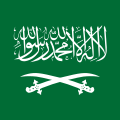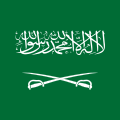Flag of Saudi Arabia
From Wikipedia, the free encyclopedia
The national flag of Saudi Arabia[a] is a green background with Arabic inscription and a sword in white. The inscription is the Islamic creed, or shahada: "There is no deity but God; Muhammad is the Messenger of God". The current design has been used by the government of Saudi Arabia since 15 March 1973.
 لَا إِلٰهَ إِلَّا اللَّٰه مُحَمَّدٌ رَسُولُ اللَّٰه('There is no deity but God; Muhammad is the Messenger of God') | |
| Use | State and war flag, state and naval ensign |
|---|---|
| Proportion | 2:3 |
| Adopted |
|
| Design | A green field with the Shahada or Muslim creed written in the Thuluth script in white above a horizontal sword, having its tip pointed to the left. |
| Designed by | Hafiz Wahba |
Design
The Arabic inscription on the flag, written in the calligraphic Thuluth Script with the current one by Saleh al-Mansouf, is the shahada or Islamic declaration of faith:
- لَا إِلٰهَ إِلَّا الله مُحَمَّدٌ رَسُولُ الله
- lā ʾilāha ʾillā-llāh, muḥammadun rasūlu-llāh
- 'There is no god but Allah; Muhammad is the Messenger of Allah.'[1]
The green of the flag represents Islam and the sword stands for the safety and justice.[2]
The flag is manufactured with identical obverse and reverse sides, to ensure the shahada reads correctly, from right to left, from either side. The sword also points to the left on both sides, in the direction of the script.[3]
The usual color of the flag's green was approximated by Album des pavillons as Pantone 330 C, while the color used on flags at United Nations is approximately Pantone 349. At the 2012 London Olympics, Pantone 355 was used.[4]
Construction sheet
| Green | White | |
|---|---|---|
| Pantone | 3425C | White |
| RGB | 0/84/48 | 240/240/236 |
| Hexadecimal | #005430 | #F0F0EC |
| CMYK | 100/0/42/67 | 0/0/2/6 |
Use
Summarize
Perspective

Because the shahada is considered holy, the flag is not normally used on T-shirts or other items. Saudi Arabia protested against its inclusion on a planned football to be issued by FIFA, bearing all the flags of the participants of the 2002 FIFA World Cup. Saudi Arabian officials said that abusing the shahada was completely unacceptable and sacrilegious. Similarly, an attempt by the U.S. military to win favour with children of the Khost Province of Afghanistan by distributing footballs adorned with flags, including that of Saudi Arabia, ended in demonstrations.[6]
The flag is never lowered to half-mast as a sign of mourning, because lowering it would be considered blasphemous and desecrating.[7] Similarly, the flags of Afghanistan and Somaliland also never at half-mast, and neither is the flag of Iraq because it bears the takbir.[8]
The normal flag cannot be hoisted vertically according to Saudi legislation. Special vertical flags are manufactured where both the inscription (the creed) and the emblem (the sword) are rotated, although this is rare, as most Arab countries traditionally do not hoist flags vertically.
History
Summarize
Perspective
The precursor states to Saudi Arabia were Nejd and Hejaz. The state flag of Nejd followed today's Saudi flag pattern very closely. The state of Hejaz followed the patterns seen in countries like Palestine and Sudan. Caliphs such as Rashiduns, Umayyads and Abbasids used different colors, inscriptions and symbols. After the Siege of Baghdad in 1258, the primary caliphate became the Mamluk Sultanate. In 1517, the Ottomans invaded Egypt and inherited Hejaz and ruled it until the Arab Revolt (1916–18). From 1902 until 1921 a different Arabic inscription was used. One of the primary opponents to the Saudis was the Emirate of Jabal Shammar of the Al Rashid family in the north of the peninsula, until their defeat in 1921.

 Flag of the First Saudi State from 1744 to 1818 and flag of the Second Saudi State from 1822 to 1891 and the flag of the Third Saudi State from 1902 to 1913
Flag of the First Saudi State from 1744 to 1818 and flag of the Second Saudi State from 1822 to 1891 and the flag of the Third Saudi State from 1902 to 1913 Flag of the Emirate of Jabal Shammar from 1835 to 1921
Flag of the Emirate of Jabal Shammar from 1835 to 1921 This flag was used by the Ottoman Empire and correspondingly by Ottoman Hejaz and Arabia from 1844-1916. The Ottomans captured Hejaz from the Mamluks in 1517.
This flag was used by the Ottoman Empire and correspondingly by Ottoman Hejaz and Arabia from 1844-1916. The Ottomans captured Hejaz from the Mamluks in 1517. Flag of the Idrisid Emirate of Asir from 1909 to 1927
Flag of the Idrisid Emirate of Asir from 1909 to 1927 Provisional flag of the Kingdom of Hejaz from 1916 to 1917
Provisional flag of the Kingdom of Hejaz from 1916 to 1917 Flag of the Sheikdom of Upper Asir from 1916 to 1920
Flag of the Sheikdom of Upper Asir from 1916 to 1920 Flag of the Kingdom of Hejaz from 1920 to 1926. This flag was also used by the Sharifian Caliphate from 1924 to 1925, before Hejaz merged with Nejd to form a union.
Flag of the Kingdom of Hejaz from 1920 to 1926. This flag was also used by the Sharifian Caliphate from 1924 to 1925, before Hejaz merged with Nejd to form a union. Flag of the Idrisid Emirate of Asir from 1927 to 1930
Flag of the Idrisid Emirate of Asir from 1927 to 1930


The Al Saud, the ruling family of Saudi Arabia, has long been closely related with Muhammad ibn Abd al-Wahhab. He and the people who followed him, since the 18th century, had used the shahada on their flags.[9] In 1921, Abdulaziz Abdulrahman Al-Saud, leader of the Al Saud and the future founder of the Kingdom of Saudi Arabia, added a sword to this flag.[9] The design of the flag was not standardized prior to 15 March 1973 when its use became official.[10] Variants with two swords and/or a white vertical stripe at the hoist were frequently used. By 1938, the flag had basically assumed its present form, except the sword had a different design (with a more curved blade) and it, along with the shahada above, took up more of the flag's space.
Royal Standard
Summarize
Perspective

The Royal Standard consists of a green flag, with an Arabic inscription and a sword featured in white, and with the national emblem embroidered in gold in the lower right canton of the year 1973.
The script on the flag is written in the Thuluth script. It is the shahada or Islamic declaration of faith:
- لَا إِلٰهَ إِلَّا الله مُحَمَّدٌ رَسُولُ الله
- lā ʾilāha ʾillā-llāh, muhammadun rasūlu-llāh
- There is no god but God; Muhammad is the Messenger of God[11]
 Royal Flag of the King of Saudi Arabia. (Ratio: 2:3)
Royal Flag of the King of Saudi Arabia. (Ratio: 2:3)- Royal Standard of the King of Saudi Arabia. (Ratio: 1:1)
 Royal Flag of the Crown Prince of Saudi Arabia. (Ratio: 2:3)
Royal Flag of the Crown Prince of Saudi Arabia. (Ratio: 2:3)- Royal Standard of the Crown Prince of Saudi Arabia. (Ratio: 1:1)
Other flags
The civil ensign, for use by merchant vessels at sea, is a green flag with the state flag in the canton with a white border. The royal standard is the state flag with the palm tree and swords in the canton.
- Flag of the Armed Forces (Ratio: 2:3)
 Flag of the Royal Saudi Land Forces (Ratio: 2:3)
Flag of the Royal Saudi Land Forces (Ratio: 2:3) Flag of the Royal Saudi Air Force (Seal) (Ratio: 2:3)
Flag of the Royal Saudi Air Force (Seal) (Ratio: 2:3) Ensign of the Royal Saudi Air Force (Roundel) (Ratio: 2:3)
Ensign of the Royal Saudi Air Force (Roundel) (Ratio: 2:3) Flag of the Royal Saudi Naval Forces. (Ratio: 2:3)
Flag of the Royal Saudi Naval Forces. (Ratio: 2:3) Flag of the Royal Saudi Air Defense Force (Ratio: 2:3)
Flag of the Royal Saudi Air Defense Force (Ratio: 2:3)- Flag of the Royal Saudi Strategic Missile Force (Ratio: 2:3)
- Flag of the Ministry of National Guard (Ratio: 2:3)
 Flag of the Ministry of Interior (Ratio: 2:3)
Flag of the Ministry of Interior (Ratio: 2:3)
See also
Notes
- Arabic: علم المملكة العربية السعودية
References
External links
Wikiwand - on
Seamless Wikipedia browsing. On steroids.







































